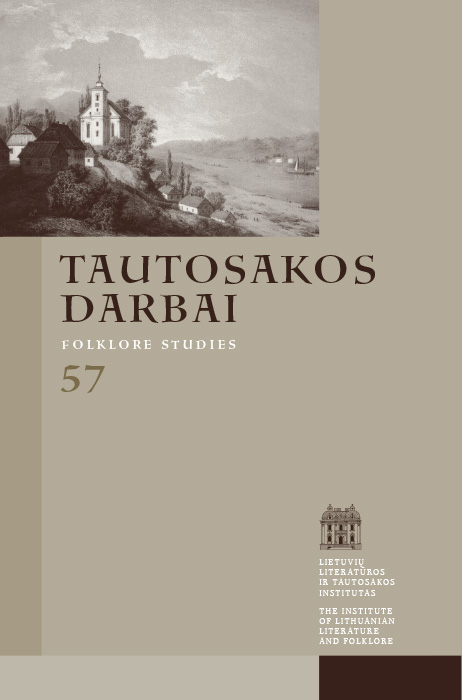Walking along the Story Road: Research on Relationship with Place
Abstract
The article presents a new research perspective on Lithuanian ancient sacred sites. The author adopts the phenomenological approach instead of the usual historical one. The phenomenological approach is centered on human experience, thus the focus shifts from the archaeological artefacts or historical data to the stories and meanings behind them. The author of the article introduces a new term – story-places, as a different definition for places that we usually call sacred sites. This allows him to temporarily set aside the religious meaning of these places and apprehend them as objects of consciousness.
The research focuses on folk narratives from two different places in western Lithuania. The first one is told by Bronislava Kučinskienė living near one of the most famous hills in Lithuania – Šatrija. Bronislava spins a complex story of her own experience while singing and dancing on top of the hill, combined with a legend about a girl encountering a witch. We learn that a folk story could be much more complicated than it seems from the first glance. It reveals different meanings of the place. On the one hand, Šatrija appears enveloped in a warm memory about activities this woman loved doing in the past. On the other hand, the hill seems unpleasant, even horrifying, when the story line turns to witches.
The second case in point evolves around Kazimieras Sereckis and Stasė Sereckienė. This couple have spent all their lives in the vicinity of the Plateliai Lake. They can tell numerous stories about this place. Both of them have a strong relationship with the lake. They know this place very well: every part of the lake has a name, and Kazimieras knows them all. Moreover, the inner calm characteristic to this couple not only affects their stories, but also their relationship with the place. The couple seems to have some kind of joint knowledge – they always tell stories together, finishing each other’s sentences. On the other hand, the Plateliai Lake, like Šatrija, also has multiple meanings. While the surface of the lake is well known and familiar, the underwater space has a completely different meaning: it is attributed to the dead, to the underworld, which also is reflected in the stories told by Kazimieras and Stasė.
The author of the article seeks to reveal the complex and uneven relationship between the human mind and the place. The phenomenological approach helps us to shift our attention and take a walk along the story road. If we look close enough, there appears a host of different meanings. No meaning is permanent – it can and it does change. There is no universal picture of a place in human mind, because every new encounter, every new story has a new perspective. This article proposes an argument in favor of using a phenomenological approach for researching the sacred sites. It focuses on people’s stories, since every place, before anything else, is a story.
Downloads
Most read articles by the same author(s)
- Andrius Kaniava, Mythical Character of Space in the Place Legends on the Plateliai Lake , Tautosakos darbai: Vol. 66 (2023): Tautosakos darbai
